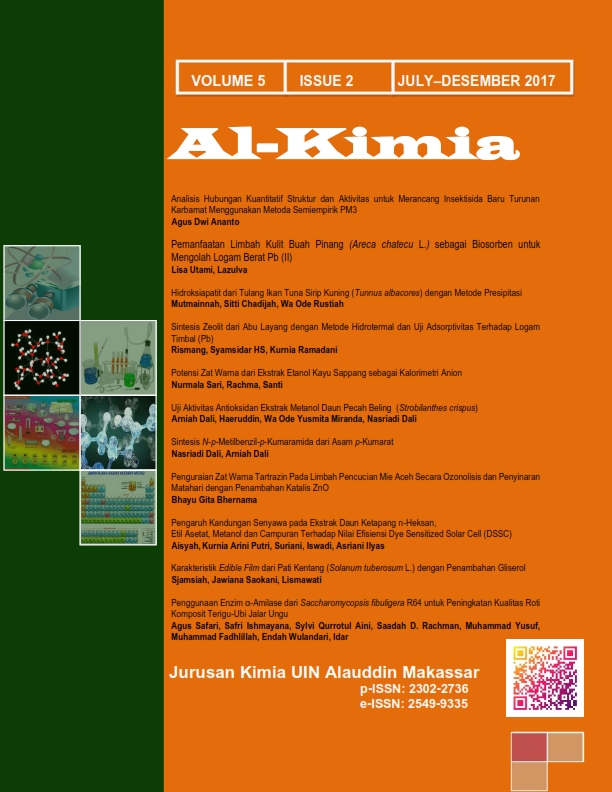Hidroksiapatit dari Tulang Ikan Tuna Sirip Kuning (Tunnus albacores) dengan Metode Presipitasi
Abstract
Indonesia as one of the biggest tuna fish produsers in the world, produce tuna fish bones large enough. Since tuna fish bone contain high calcium it is potentially to be the raw material of hydroxyapatite. Hydroxyapatite are inorganic compounds constituent of bones and teeth has the moleculer formula Ca5(PO4)3OH. Synthesis of hydroxyapatite can be done with precipitation method through tuna fish bone calcination process at the temperature 900°C for 5 hours to obtain calcium compounds in the form of calcium oxide. Calcium wich has been obtained added phosphoric acid 0,6 M with flow rate/rapid 1 mL/minute. Controlled synthesis process parameters are pH 10 of solution. Yield of hydroxyapatite generated after synthesis with of the precipitation time 12 hours are of 91.15%. hydroxyapatite product obtained was analyzed by FTIR(Fourier Transform Infrared) and XRD (X-Ray Diffraction). FTIR analysis indicate the presence of OH groups, PO4 and CO3. Based on the resulting diffraction of XRD analysis, crystallite size obtained each of 211.29 nm structure is hexagonal. Scherrer method was used to obtain crystallite size.
Downloads
References
Aisyah, D., Mamat, I., Sontang, M., Rosufila, Z. & Ahmad, N.M. (2012). Program pemanfaatan sisa tulang ikan untuk produk hidroksiapatit: Kajian di pabrik pengolahan kerupuk lekop Kuala Trengganu-Malaysia. Jurnal Sosioteknologi, 26, 129-141.
Andika, R, Fadli, A. & Irdoni HS. (2015). Pengaruh waktu aging dan kecepatan pengadukan pada sintesis hidroksiapatit dari cangkang telur dengan metode presipitasi. JOM FTeknik, 2(1), 1-8.
Defandi, F. (2015). Sifat fisiko kimia minyak ikan dari limbah pengolahan ikan tuna (Thunnus sp). Skripsi, Universitas Andalas, Padang.
Ebrahimi-Kahrizsangi, R. & Nasiri-Tabrizi, B. (2011). Characterization of crystal fluoroapatite nanoparticles synthesized via mechanochemical method. Particuology,.9(5), 537-544.
Kim, S & Mendis, E. (2006). Bioactive compounds from marine processing by products-a review. Food Research International. 39, 383-393.
Ignjatovic, N., Tomic, S., Dakic, M., Miljkovic, M., Plavsic, M., & Uskokovic, D. (1999). Synthesis and properties of hydroxyapatite/poly-L-lactide composite biomaterials. Journal Biomaterials, 20(9), 809-816.
Mohammad, N.F., Othman, R. & Yee-Yeoh, F. (2014). Nanoporous hydroxyapatite preparation methods for drug delivery application”. Red. Adv. Mater. Sci.38, 138-147.
Murniyati, Dewi, F.R. & Rosmawaty . (2014). Teknik Pengolahan Tepung Kalsium Dari Tulang Ikan Nila. Jakarta, Penebar Swadaya.
Nayak & Kumar, A. (2010). Hydroxyapatite synthesis methodologies: An overview. International Journal of ChemThech Research. 2(2), 903-907.
Rahajeng, M. (2012). Ikan tuna Indonesia. Warta Ekspor Kementerian Pedagangan. 6(3), 1-20.
Riyanto, B., Maddu, A. & Nurrahman. (2013). Material biokeramik berbasis hidroksiapatit tulang ikan tuna. JPHPI, 16(2), 119-132.
Rujitanapanich, S., Kumpapan, P. & Wanjanoi. P. (2014). Synthesis of hidroxyapatite from oyster shell via precipitation. Energy Procedia. 56, 112-117.
Trilaksani, W., Salamah, E. & Nabil, M. (2006). Manfaat limbah tulang ikan tuna (Thunnus sp.) sebagai sumber kalsium dengan metode hidrolisis protein. Buletin Hasil Perikanan. 9(2), 36-45.
Copyright (c) 2017 Al-Kimia

This work is licensed under a Creative Commons Attribution-NonCommercial-ShareAlike 4.0 International License.
Authors who publish with this journal agree to the following terms:
1) Authors retain copyright and grant the journal right of first publication with the work simultaneously licensed under a Creative Commons Attribution License that allows others to share the work with an acknowledgement of the work's authorship and initial publication in this journal.
2) Authors are able to enter into separate, additional contractual arrangements for the non-exclusive distribution of the journal's published version of the work (e.g., post it to an institutional repository or publish it in a book), with an acknowledgement of its initial publication in this journal.
3)Authors are permitted and encouraged to post their work online (e.g., in institutional repositories or on their website) prior to and during the submission process, as it can lead to productive exchanges, as well as earlier and greater citation of published work (See The Effect of Open Access).


